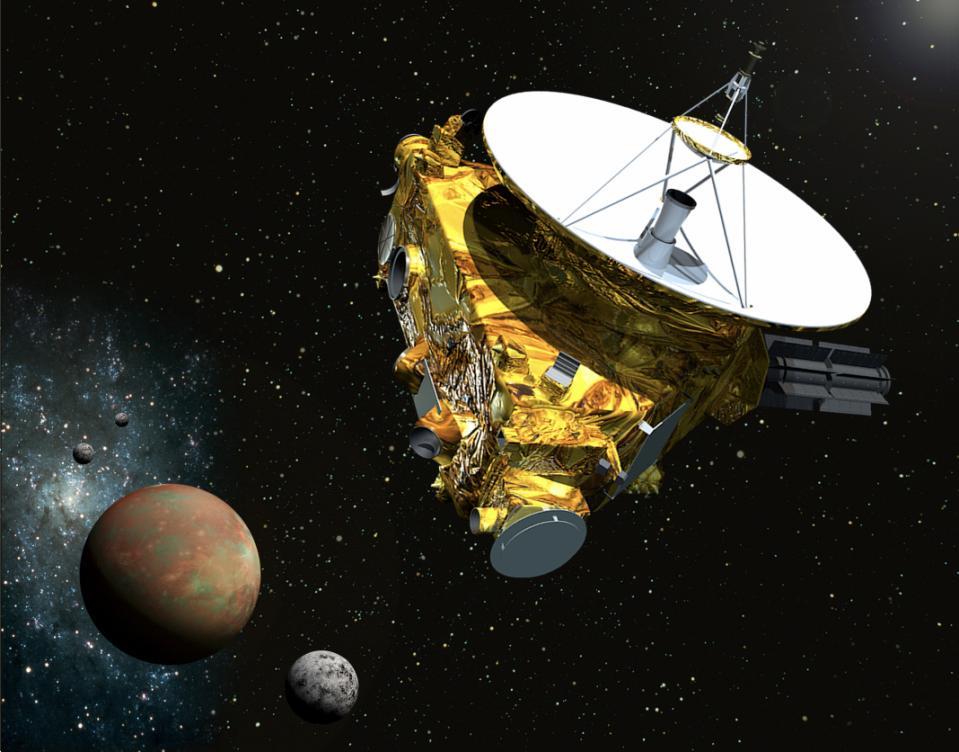January 19, 2015
NASA’s New Horizons spacecraft is whizzing to the outer reaches of our solar system, where it will perform the first close-up flyby of Pluto.

January 19, 2015
NASA’s New Horizons spacecraft is whizzing to the outer reaches of our solar system, where it will perform the first close-up flyby of Pluto.

An undated artist's concept made available by NASA and the Johns Hopkins University Applied Physics Laboratory/Southwest Research Institute (JHUAPL/SwRI) on December 8, 2014 shows the New Horizons spacecraft as it approaches Pluto and its three moons in summer 2015.
The piano-size probe took off from Earth in January 2006. It is on track to soar close to the dwarf planet and within the orbit of its five known moons on July 14 — after 3 billion miles.
“It’s an incredibly exhilarating and humbling experience to think this is civilization’s first step to see the Kuiper belt. It’s not going to happen, I think, in my lifetime again,” Hal Weaver, a New Horizons project scientist, said in an interview with Yahoo News.
Weaver, who works at the Johns Hopkins University Applied Physics Laboratory in Laurel, Md., says that a relatively small team of scientists has been working on the project at any given time. Right now, there are about 10, but that number will approach 50 as the probe reaches Pluto.
The groundbreaking journey could shed light on the Kuiper belt, a region of the solar system that we do not know much about.
For Earthlings, the reconnaissance mission is expected to transform this little pixelated blob into a vibrant world full of complexity and diversity, with new information vastly superior to what we now have.
“When future civilizations look back at the landmark things that happened, they will, if all goes well, see this as our first foray into this new zone that we didn’t even know existed until 1992,” Weaver said.
New Horizons, the fastest spacecraft ever launched, awoke from hibernation last month and will snap long-range photos of the Pluto system using the telescopic Long-Range Reconnaissance Imager (LORRI).
Over the next few months, the spacecraft will beam hundreds of ever-improving images back to mission scientists. The images will help chart the course for the remaining 135 million miles.
“This is a mission of delayed gratification, but the gratification is about to come,” Weaver said, laughing.
Excitement surrounding the mission is rippling through the scientific community.
Denton Ebel, a geologist specializing in meteorites at the American Museum of Natural History in New York, said there is so much about the Kuiper belt that we just don’t know because of the distance — 4.67 billion miles from Earth.
“What are the moons made of? Are they big ice balls? Are any rocky? We just don’t know. What these bodies are made out of is the most interesting part of what we are going to learn,” Ebel said in an interview with Yahoo News.
The extraterrestrial rock expert pointed out that we were not even aware of all of Pluto’s currently known moons when New Horizons launched.
Now we are on the cusp of a quantum leap forward in our understanding of the Kuiper belt, which could, in turn, shed tremendous light on the formation of our solar system 4.6 billion years ago.
“We live in exciting times,” Ebel said.
Courtesy: Yahoo News












































































































